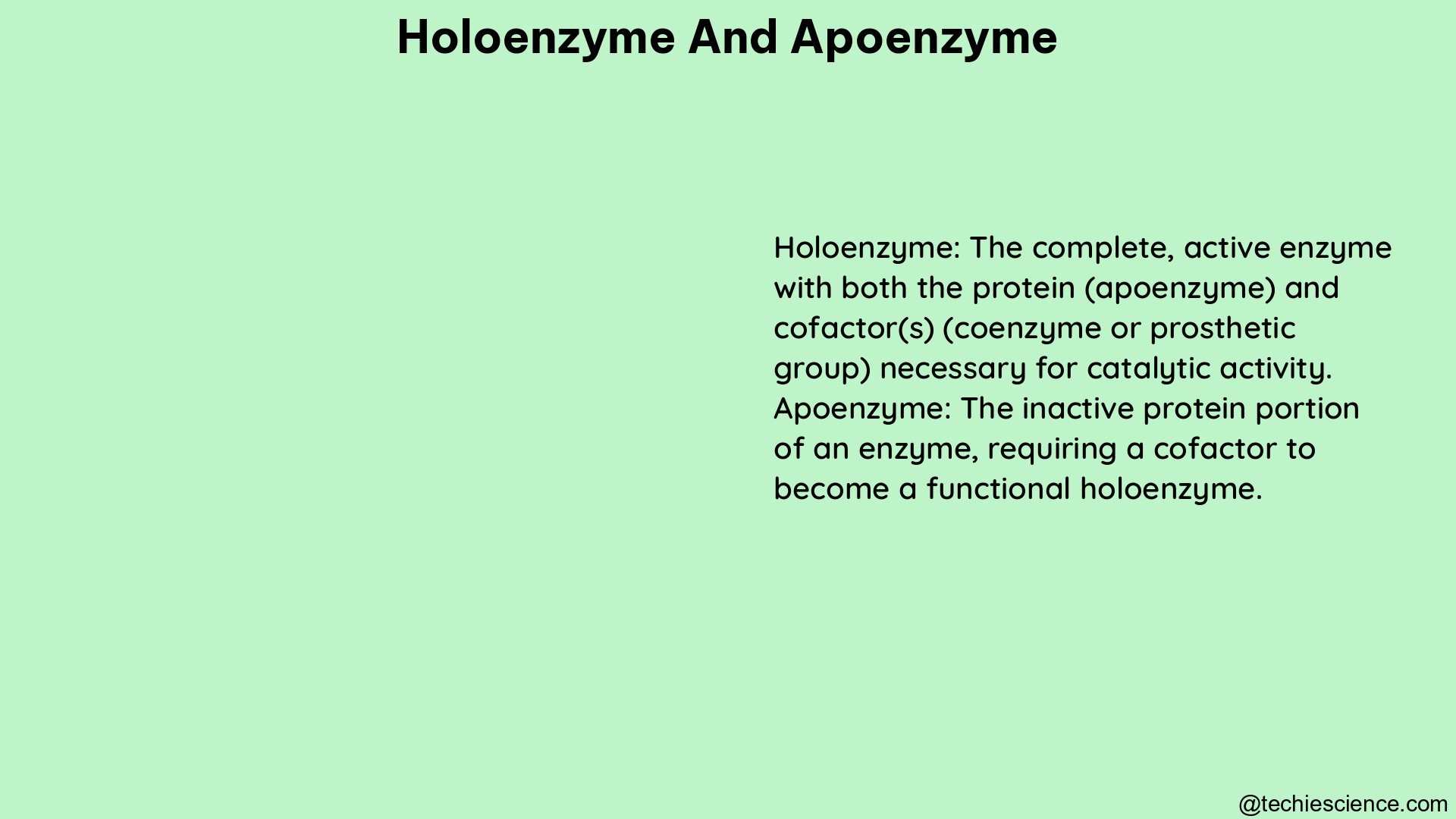Holoenzyme and apoenzyme are crucial concepts in the field of biochemistry and molecular biology. Apoenzyme, the protein portion of an enzyme, combines with a non-protein cofactor to form the holoenzyme, which is the fully functional form of the enzyme. This article will delve into the biological specifications of holoenzyme and apoenzyme, focusing on measurable and quantifiable data.
Holoenzyme: The Fully Functional Form
Holoenzymes are the active forms of enzymes, resulting from the combination of apoenzymes and cofactors. These cofactors can be inorganic ions, such as Mg2+, Zn2+, or Fe2+, or organic molecules known as coenzymes, like NAD+, FAD, and Coenzyme A. The holoenzyme’s activity is significantly higher than that of the apoenzyme alone, emphasizing the importance of the cofactor in enzyme function.
A study on the quantitative measure of conformational changes in apo, holo, and ligand-bound forms of enzymes provides valuable insights into the structural changes that occur upon ligand binding. The researchers observed that structural changes, such as changes in the secondary and tertiary structures, take place during the binding of the ligand in the presence of the cofactor, highlighting the dynamic nature of holoenzyme formation. This study underscores the significance of understanding the level of flexibility in protein-ligand interactions for computer-aided drug designing.
For example, the enzyme alcohol dehydrogenase (ADH) is a holoenzyme that requires the cofactor NAD+ for its catalytic activity. The apoenzyme, which is the protein portion of ADH, cannot efficiently catalyze the oxidation of ethanol to acetaldehyde without the presence of the NAD+ cofactor. The binding of NAD+ to the apoenzyme induces conformational changes that optimize the active site geometry and facilitate the catalytic reaction.
Apoenzyme: The Protein Portion

Apoenzymes are the protein components of enzymes that combine with cofactors to form holoenzymes. The term “prosthetic group” refers to minerals, activated vitamins, or other non-protein compounds that bind to apoenzymes to create holoenzymes.
In the context of glycolysis, one of the enzymes, aldolase, requires Zn2+ for catalysis, illustrating the importance of cofactors in enzyme function. This example underscores the role of apoenzymes in catalyzing biochemical reactions and the necessity of cofactors for their full functionality.
Apoenzymes can be classified based on their structural and functional characteristics:
- Catalytic apoenzymes: These apoenzymes possess the active site and are responsible for the catalytic activity of the enzyme.
- Regulatory apoenzymes: These apoenzymes are involved in the regulation of enzyme activity, often through allosteric mechanisms or post-translational modifications.
- Structural apoenzymes: These apoenzymes provide structural support and stability to the enzyme complex, but do not directly participate in the catalytic process.
The binding of the cofactor to the apoenzyme can induce conformational changes that optimize the active site geometry, enhance substrate binding, and facilitate the catalytic reaction. The strength of the apoenzyme-cofactor interaction is often quantified using dissociation constants (Kd), which can range from nanomolar to millimolar, depending on the specific enzyme-cofactor system.
Measurable and Quantifiable Data
Measurable data on holoenzymes and apoenzymes can be obtained through various experimental techniques, such as:
- Spectroscopic methods:
- UV-Vis spectroscopy: This technique can provide information on the electronic transitions and absorption spectra of enzymes, which can be used to monitor changes in the environment of chromophores (e.g., aromatic amino acids) upon cofactor binding or ligand interactions.
- Fluorescence spectroscopy: This method can be used to study the conformational changes and dynamics of enzymes by monitoring the fluorescence emission of intrinsic fluorophores, such as tryptophan residues, in the presence and absence of cofactors or ligands.
-
Circular dichroism (CD) spectroscopy: CD spectroscopy can provide insights into the secondary and tertiary structural changes of enzymes upon cofactor binding or ligand interactions, as it is sensitive to the chiral environment of the protein.
-
Calorimetric methods:
-
Differential scanning calorimetry (DSC): DSC can be used to measure the thermodynamic parameters of enzyme-ligand or enzyme-cofactor interactions, such as enthalpy (ΔH), entropy (ΔS), and heat capacity changes (ΔCp). These data can provide insights into the energetics and mechanisms of holoenzyme formation.
-
Structural biology techniques:
- X-ray crystallography: This technique can provide high-resolution three-dimensional structures of apoenzymes and holoenzymes, allowing for the analysis of conformational changes and the identification of binding sites for cofactors and ligands.
- Nuclear magnetic resonance (NMR) spectroscopy: NMR can be used to study the structural dynamics and interactions of enzymes in solution, including the binding of cofactors and ligands, as well as the conformational changes that occur during the catalytic process.
These experimental techniques, combined with computational methods, such as molecular dynamics simulations and docking studies, can provide a comprehensive understanding of the structural and functional relationships between apoenzymes, cofactors, and holoenzymes, which is crucial for the development of targeted enzyme-based therapies and the optimization of industrial biocatalytic processes.
References
- A quantitative measure of conformational changes in Apo, Holo, and ligand-bound form of enzymes. Interdiscip Sci. 2015 Apr 11. doi: 10.1007/s12539-014-0251-8.
- Apoenzyme – an overview | ScienceDirect Topics. https://www.sciencedirect.com/topics/neuroscience/apoenzyme
- Chapter 6 Flashcards – Quizlet. https://quizlet.com/464770323/chapter-6-flash-cards/
- Apoenzyme – an overview | ScienceDirect Topics. https://www.sciencedirect.com/topics/pharmacology-toxicology-and-pharmaceutical-science/apoenzyme
- Questions 6 Flashcards – Quizlet. https://quizlet.com/31964383/questions-6-flash-cards/
Hi …I am Tulika Priyadarshini, I have completed my Master’s in Biotechnology. Writing gives me mental peace and satisfaction. Sharing the knowledge that I gain in the process is a cherry on the cake. My articles are related to Lifesciences, Biology and Biotechnology. Lets connect through LinkedIn-